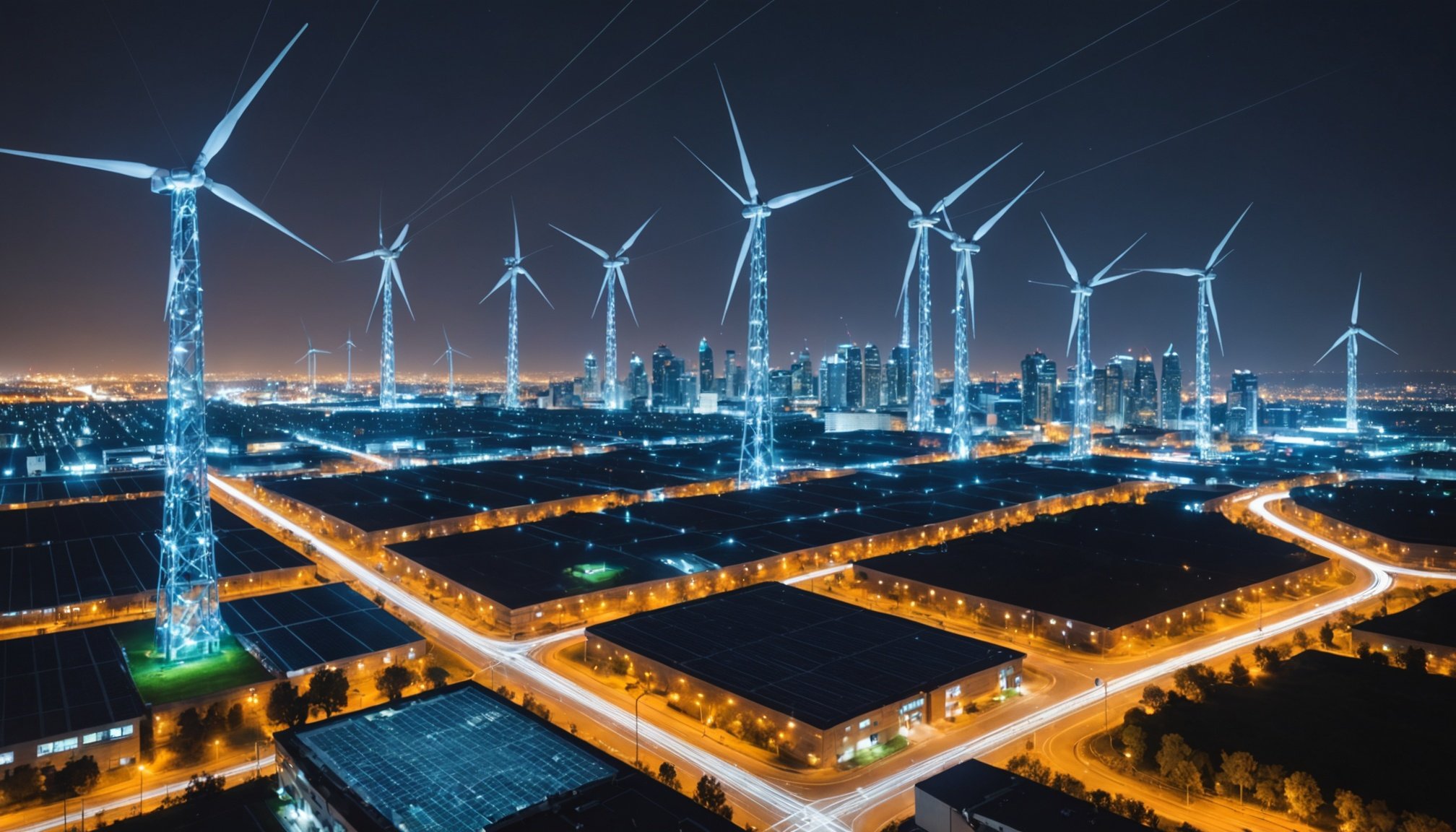Introduction to AI and Smart Grids
Smart grids represent a crucial development in modern energy infrastructure, integrating digital technology to enhance energy efficiency and reliability. Unlike traditional grids, smart grids facilitate two-way communication, allowing better management of energy flows and real-time data collection. This infrastructure forms the backbone for AI-driven innovation. By processing vast amounts of data, AI can optimize energy distribution and consumption, leading to more resilient and responsive energy systems.
The Role of AI in Smart Grids
AI plays a transformative role in smart grids through predictive analytics, which forecasts energy demand with precision, reducing waste and improving grid stability. Machine learning algorithms further assist by facilitating adaptive demand response, adjusting energy use based on real-time conditions. This not only enhances operational efficiency but also fosters sustainable energy practices by minimizing unnecessary energy production.
This might interest you : Transforming Precision: Innovative Strategies for Enhanced AI Fraud Detection
Moreover, the importance of energy efficiency is accentuated in modern smart grids due to the growing emphasis on renewable energy sources. AI helps integrate these sources seamlessly, ensuring balance between demand and supply while reducing carbon footprints. These advancements underscore the pivotal role of AI, not just in managing electricity but in steering towards a sustainable energy future.
The continued development and integration of AI in smart grids promise a future of innovative energy solutions.
This might interest you : Building a Fast and Trustworthy Blockchain Ecosystem for Secure Financial Transactions
Key AI Strategies Transforming Smart Grids
In the evolving landscape of smart grids, AI strategies are crucial for efficient and reliable energy management. Predictive analytics is a standout technology, enabling precise energy demand forecasting. By analysing historical and real-time data, AI can predict consumption patterns, allowing grids to balance supply and demand proactively.
Machine learning algorithms enhance this forecasting by facilitating adaptive demand response. These algorithms adjust energy distribution based on current conditions, ensuring optimal grid performance and increased energy efficiency. Adaptive demand response assists in mitigating peak load scenarios, thus avoiding the need for excessive energy generation.
AI-driven grid management systems are central to this transformation. These systems integrate various AI technologies to automate and optimize operations, from fault detection to energy routing. The incorporation of machine learning and predictive models aids in delivering energy solutions both reliably and sustainably.
Realizing the benefits of AI in smart grids involves complex data processing, yet the advantages are undeniable. By innovatively applying AI strategies, utilities can significantly reduce wastage, enhance grid resilience, and support the incorporation of renewable energy sources. The strategic utilisation of AI not only drives technological innovation but also propels towards a more sustainable and energy-efficient future.
Case Studies of AI Implementation in Smart Grids
Successful Smart Grid Projects Utilizing AI
AI is reshaping the landscape of smart grids through real-world applications. Notable projects have demonstrated the efficacy of AI in enhancing energy systems. For instance, London’s autonomous energy network efficiently manages fluctuations in supply and demand by precisely analysing real-time data. Such AI-driven optimization leads to substantial energy savings and ensures energy efficiency.
Lessons Learned from AI Integration
From these pioneering projects, critical insights emerge. Successful integration hinges on robust data collection and processing capabilities. Consistent updates and maintenance of AI models ensure they adapt to varying energy patterns. Key lessons underline that while AI brings transformative benefits, its implementation requires meticulous planning and continuous evaluation.
Comparative Analysis of Traditional vs. AI-Enhanced Systems
Contrasting traditional energy systems with AI-enhanced grids reveals stark differences in performance. AI systems offer heightened reliability and responsiveness, facilitating dynamic energy allocation. In contrast, traditional systems struggle with static responses, often resulting in inefficiencies. The shift towards AI-driven solutions signals a move towards more sustainable and effective energy management.
In exploring these real-world applications, the case studies illustrate not only the potential AI offers but the growing necessity to adopt these technologies for future-ready, energy-efficient smart grids.
Technological Advancements in AI for Energy Efficiency
The ongoing evolution of AI Innovations in energy technology is driving substantial advancements in smart grid applications. Recent innovations emphasize predictive capabilities that enhance energy efficiency. These developments are pivotal in optimizing grid operations, ensuring minimal energy waste while boosting performance.
Emerging trends in intelligent grid systems include the use of advanced machine learning models to determine energy consumption patterns more accurately. By leveraging real-time data, these models significantly reduce discrepancies between energy supply and demand. Furthermore, the integration of AI-driven algorithms enables preemptive fault detection and resolution, safeguarding grid stability and performance.
As the technology landscape matures, an optimistic outlook on intelligent grid systems emerges. Continued advancements are expected to facilitate seamless integration with renewable energy sources, ensuring a balanced and sustainable energy ecosystem. These innovations not only improve the reliability of energy networks but also empower consumers with intelligent energy management tools.
Future prospects include the widespread adoption of AI Innovations that anticipate and adapt to fluctuating energy requirements in real time, marking a transformative shift in energy management. Overall, the synergy between energy technology and AI is set to redefine efficiency benchmarks, fostering a more responsible and eco-friendly energy future.
Challenges of Integrating AI into Smart Grids
As fascinating as the integration of AI in smart grids is, several challenges must be navigated. Primarily, data privacy and cybersecurity concerns arise when vast amounts of sensitive data circulate through digital systems. Ensuring the protection of this data from breaches is a critical aspect of smart grid implementation.
Another significant challenge is the scalability of AI systems. While AI can optimize energy use on smaller scales, scaling up these systems to accommodate extensive grid networks requires robust infrastructure and sophisticated algorithms. This scalability ensures consistent performance across diverse and expansive systems.
Additionally, navigating the complex landscape of regulations presents an ongoing challenge. Regulatory and policy challenges necessitate that AI systems conform to standards, ensuring safety and reliability without stifling innovation. As smart grids operate under diverse jurisdictional regulations and policies, harmonizing these systems poses considerable hurdles.
Overcoming these challenges involves developing adaptive AI technologies that balance security and efficiency. Moreover, continued collaboration between industry stakeholders, regulatory bodies, and policymakers is essential to create a conducive environment for AI integration. Addressing these areas will be crucial for successfully leveraging AI’s potential in enhancing the efficiency and reliability of smart grids.
The Future of AI in Enhancing Energy Efficiency
As smart grids continue to evolve, the future of AI in energy efficiency appears promising and transformative. Predictions indicate that AI will not only improve existing energy systems but also revolutionize the integration of renewable energy sources. AI’s ability to process vast datasets will fine-tune the balance between supply and demand, paving the way for innovative efficiency enhancements.
One expected advancement is the development of consumer-level energy management tools. These tools empower consumers to monitor and control energy consumption, promoting sustainable energy usage. User-friendly interfaces and personalised insights from AI will motivate energy-efficient practices.
Moreover, AI is likely to facilitate significant strides in the use of renewable energy. As AI-driven algorithms become more sophisticated, they enhance the predictability of renewable sources like solar and wind. This predictability aids in seamlessly integrating renewables into the grid, ensuring consistent and reliable energy supply.
The exploration of future trends in AI suggests that these innovations will continue to unlock more efficient and sustainable energy solutions. For consumers and industries alike, the potential of AI in enhancing energy efficiency will be an instrumental driver towards sustainability goals and advancing smart grid technologies.


